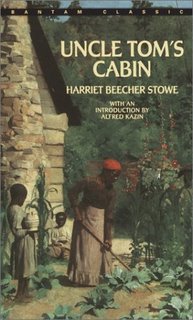Uncle Tom's Cabin
 Uncle Tom's Cabin, by Harriet Beecher Stowe
Uncle Tom's Cabin, by Harriet Beecher StoweOkay, here goes. (By the way, I'm feeling like my "academic muscles" are way flabbier than yours, Lis. :-)
While reading The Autobiography of Malcom X, I was inspired to read Uncle Tom's Cabin because in his autobiography, Malcom X made countless references to the "Uncle Toms" of society. I had a vague notion as to what he was referring, but was curious to know the story. (I'll give a little background): For most of his adult life, except for the last few years, Malcolm X viewed most pro-integration African-Americans as an "Uncle Tom," (particularly the ones who befriended White men) seeing them as far too forgiving, too submissive and not taking enough control over their own lives. This was interesting to me since I had understood Uncle Tom to be a role-model, or in the least the most respected character in Uncle Tom's Cabin.
The story begins at a plantation in Kentucky where the slave-owners are described as kind and gentle to all - taking part in slave trade only because it is the way of society, not because they are racist. So, Harriet Beacher Stowe begins by painting a picture of the most "ideal" slavery conditions: Uncle Tom is the so-called "manager" of the plantation, he shares a cabin with his wife, Chloe, and two small boys and has a well-established working relationship with the plantation owner, Mr. Shelby. Another woman, Eliza, is Mrs. Shelby's personal assistant and stays in the house along with her own son. Eliza soon finds out that Mr. Shelby is in serious debt and that the only way out of it is to sell his most valued servant - Uncle Tom - as well as Eliza's son, (since young children could often prove to be of high value, if purchased early). Upon learning the news, Eliza informs Tom and decides to escape with her child in the night, in hopes of making the journey to Canada. Tom, being the obedient and loyal slave that he is, decides to stay and take the hand that he is dealt, no matter where it leads him.
The remainder of the story goes back and forth between Eliza and Uncle Tom, following each of them on their journeys, with Tom letting others control his fate and Eliza trying with everything in her to control her own. I should add, though, that Uncle Tom is a devout Christian and puts all his faith in the saving grace of Christ, which is why he allows himself to be taken from place to place - always with the hope that the Lord will provide in His own time.
Through their journeys the reader sees everything from the kindest to the cruelest slave-owners, the best possible living conditions to the most horrific and de-humanizing conditions, and the most "spoiled" to the most "savage" African-American slaves. As Eliza and her son are hunted, and Tom is towed from one slaveholder to the next, the reader gets a solid picture of the way slavery permeated all of society - in the both the south and the north. From the plantation-owners to the slave-traffickers, to the auction leaders, to the restaurant-owners and to the underground railroad workers, slavery was ever-present, and horrifyingly normalized.
There are times in the story when, as a reader who understands the time in which this was written, you wonder how forgiving Harriet Beecher Stowe will be in the end, or if she will be forgiving at all. In other words, this was written before the Civil War, and in order to get it published, it seems logical that she would have had to be forgiving of White society - at least to some degree. So I found myself wondering how dark it would become in the end. (I will leave that for you who haven't yet read it to discover, but I thought it an interesting consideration: How honest will the author be?)
Uncle Tom's Cabin seems to be one of those "must reads" if you want to be an educated person in society. :-) It is a story that opens eyes to a history we cannot ignore, or forget about. As well, it inevitably turns the reader's thoughts to the present to consider the level of improvement we humans have made in this area: Has racism in general decreased? (We know that globally it hasn't, but what about in your own cities?) ...But not just that. How are the hierarchies of society that make a few powerful and most marginalized similar to slavery? How do we view each other, particularly in the competitive society in which we live?
If any of my lovely sisters want to discuss this more we can, but otherwise, it's food for thought (a lot of thought). I highly recommend this book. It's a bit hard to get into the language, but once you're in, the characters come alive and your emotions are invested in their stories. Harriett Beecher Stowe definitely created a masterpiece.



1 Comments:
Mich, this is a really good review! You ask some great questions--I like the way you think! I read this for an American lit class, and have heard it dismissed as racist because of Tom's submissiveness, but it was HUGELY influential in the anti-slavery movement. What this book did was show not only the brutality of slavery, but it also showed the world that slaves were people, with feelings and families, and that sometimes they were even heroes. You're right Mich, everyone should read this book! Great selection!
Post a Comment
<< Home